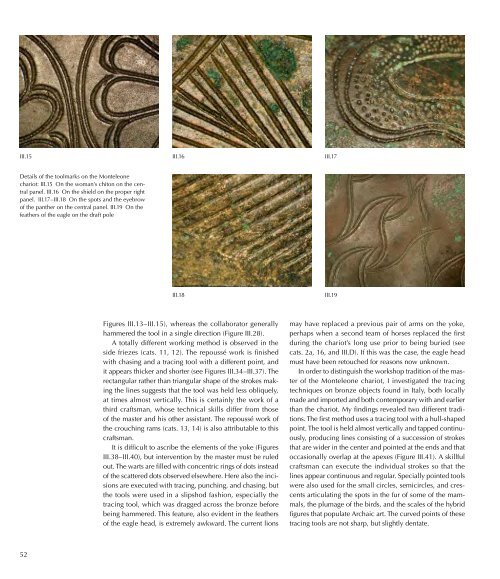Journal - Comune di Monteleone di Spoleto
Journal - Comune di Monteleone di Spoleto
Journal - Comune di Monteleone di Spoleto
You also want an ePaper? Increase the reach of your titles
YUMPU automatically turns print PDFs into web optimized ePapers that Google loves.
iii.15 iii.16 iii.17<br />
details of the toolmarks on the monteleone<br />
chariot: iii.15 on the woman’s chiton on the central<br />
panel. iii.16 on the shield on the proper right<br />
panel. iii.17 – iii.18 on the spots and the eyebrow<br />
of the panther on the central panel. iii.19 on the<br />
feathers of the eagle on the draft pole<br />
52<br />
iii.18 iii.19<br />
Figures iii.13– iii.15), whereas the collaborator generally<br />
hammered the tool in a single <strong>di</strong>rection (Figure iii.28).<br />
a totally <strong>di</strong>fferent working method is observed in the<br />
side friezes (cats. 11, 12). The repoussé work is finished<br />
with chasing and a tracing tool with a <strong>di</strong>fferent point, and<br />
it appears thicker and shorter (see Figures iii.34 – iii.37). The<br />
rectangular rather than triangular shape of the strokes making<br />
the lines suggests that the tool was held less obliquely,<br />
at times almost vertically. This is certainly the work of a<br />
third craftsman, whose technical skills <strong>di</strong>ffer from those<br />
of the master and his other assistant. The repoussé work of<br />
the crouching rams (cats. 13, 14) is also attributable to this<br />
craftsman.<br />
it is <strong>di</strong>fficult to ascribe the elements of the yoke (Figures<br />
iii.38– iii.40), but intervention by the master must be ruled<br />
out. The warts are filled with concentric rings of dots instead<br />
of the scattered dots observed elsewhere. Here also the incisions<br />
are executed with tracing, punching, and chasing, but<br />
the tools were used in a slipshod fashion, especially the<br />
tracing tool, which was dragged across the bronze before<br />
being hammered. This feature, also evident in the feathers<br />
of the eagle head, is extremely awkward. The current lions<br />
may have replaced a previous pair of arms on the yoke,<br />
perhaps when a second team of horses replaced the first<br />
during the chariot’s long use prior to being buried (see<br />
cats. 2a, 16, and iii.d). if this was the case, the eagle head<br />
must have been retouched for reasons now unknown.<br />
in order to <strong>di</strong>stinguish the workshop tra<strong>di</strong>tion of the master<br />
of the monteleone chariot, i investigated the tracing<br />
techniques on bronze objects found in italy, both locally<br />
made and imported and both contemporary with and earlier<br />
than the chariot. my fin<strong>di</strong>ngs revealed two <strong>di</strong>fferent tra<strong>di</strong>tions.<br />
The first method uses a tracing tool with a hull-shaped<br />
point. The tool is held almost vertically and tapped continuously,<br />
producing lines consisting of a succession of strokes<br />
that are wider in the center and pointed at the ends and that<br />
occasionally overlap at the apexes (Figure iii.41). a skillful<br />
craftsman can execute the in<strong>di</strong>vidual strokes so that the<br />
lines appear continuous and regular. Specially pointed tools<br />
were also used for the small circles, semicircles, and crescents<br />
articulating the spots in the fur of some of the mammals,<br />
the plumage of the birds, and the scales of the hybrid<br />
figures that populate archaic art. The curved points of these<br />
tracing tools are not sharp, but slightly dentate.


